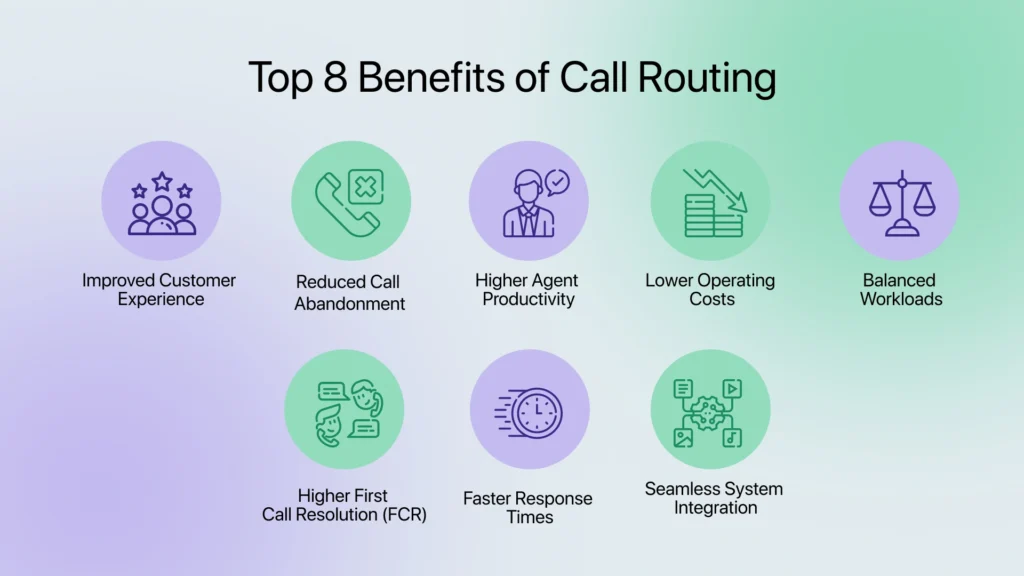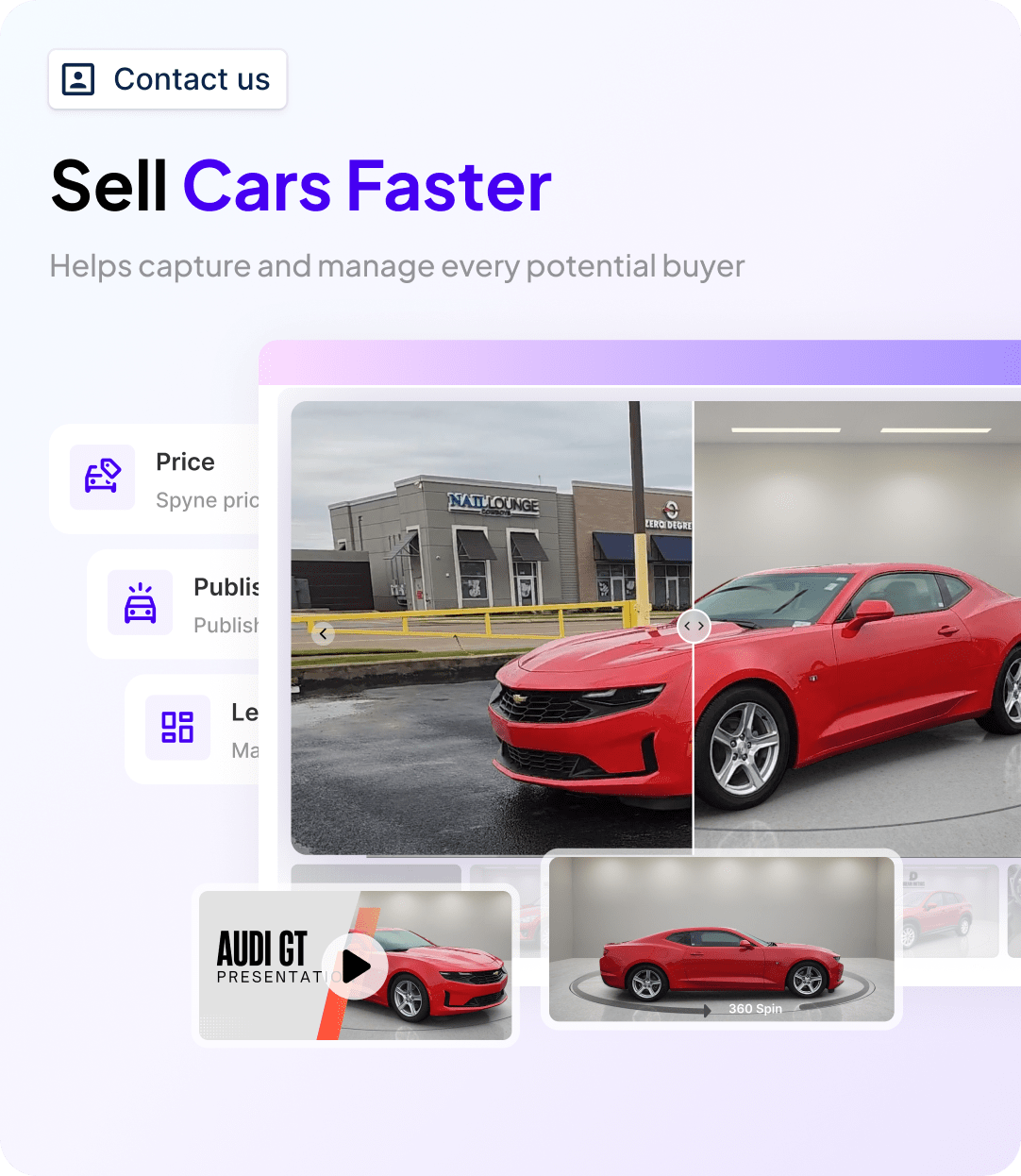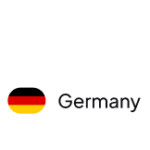Call routing helps businesses answer calls faster by sending each caller to the right person or department. This means customers don’t have to wait on hold for long or be transferred again and again. A smart routing system uses automation and rules to direct calls based on time, agent availability, or what the caller selects in a menu. It’s very useful for busy teams or call centers that get a lot of calls every day. In fact, 70% of customers say fast response time matters most, and many hang up if they wait too long. Call routing helps fix that. In this blog, we’ll explain what call routing is, how it works, its key benefits, and how to set it up the right way for your business.
What is Call Routing?
Call routing is a simple way to manage incoming business calls. It automatically sends each call to the right person or team based on rules you set, like the time of day, who’s available, or what the caller chooses in the menu. This setup is often called an Automatic Call Distributor (ACD). It keeps calls moving without needing a receptionist or manual transfers.
For example, if someone calls after hours, the system can send them to voicemail. If they press “1” for sales, the call goes to the sales team. If no one is free, they can even schedule a callback instead of waiting.
Call routing systems are used by many businesses to handle more calls, avoid long holds, and make sure every caller talks to the right person. With the help of call routing software, you can improve customer service and reduce missed calls.
What is Automated Call Routing?
Automated call routing (also called automatic call distribution or ACD) is a phone system that sends incoming calls to the right agent or team based on set rules. These rules can be things like the time of the call, which team is needed, what the caller chooses, or which agent is free.
Unlike basic call routing, no one needs to transfer the call manually. The system does it automatically. This saves time and gives a better experience to the caller.
Today’s routing systems also use AI to understand calls better and send them to the best person faster. This is very helpful for small teams or busy call centers. It helps you answer more calls, saves time, and makes sure every caller reaches the right person without delay.
Top 8 Benefits of Call Routing for Businesses in 2025
Call routing helps businesses manage customer calls in a faster, smarter way. It gets each caller to the right person or department without delays or confusion. Whether you’re running a small team or a busy call center, the benefits of a proper call routing system are huge for your customers, agents, and your bottom line.
1. Improved Customer Experience
Customers want fast, helpful responses. Call routing connects them directly to someone who can actually solve their problem. This reduces long hold times, endless transfers from one team to another within the business.
2. Reduced Call Abandonment
If callers wait too long, they hang up, and possibly won’t call back. A good routing system decreases this risk by quickly placing them with the right person, offering a callback option, or using conversational AI to engage the caller instantly. That keeps them engaged and reduces missed opportunities.
3. Higher Agent Productivity
When agents get calls, they’re trained to handle whether through traditional inbound routes or AI cold calling, they work faster and with more confidence. Skills-based call routing ensures agents aren’t stuck solving problems they’re not equipped for, which improves both efficiency and morale.
4. Lower Operating Costs
Automatic call routing helps you handle more calls with less people.It shortens call times, lowers the need for extra hires during peak hours, and reduces training time by sending calls directly to the right agent or by using automotive call centre outsourcing when internal capacity is maxed out.

5. Balanced Workloads
Smart phone routing systems share incoming calls equally among agents. This stops some team members from getting too many calls, helps prevent stress or burnout, and makes sure everyone gets a fair amount of work, whether they’re handling support or sales.
6. Higher First Call Resolution (FCR)
Call routing increases the chances of solving a customer’s issue on the first try. With intelligent call routing and an automated lead follow up system, customers are matched with the best-suited agent, improving satisfaction and reducing repeat calls.
7. Faster Response Times
With routing rules based on availability, skill, or location, calls are answered quickly. This meets customers’ demand for immediate support, improving satisfaction and reducing pressure on your team.
8. Seamless System Integration
Modern call routing software works with your CRM, helpdesk, and phone systems. Agents can access caller info instantly, reducing back-and-forth and keeping your operations smooth and efficient.
15 Different Types of Call Routing Rules
A good call routing system gives you full control over how customer calls are handled. You can choose from different routing rules that match your business needs. These rules help you route calls to the right person, using smart logic like time, agent availability, customer value, or location. Whether you use automated call routing, an intelligent call routing system, or a basic call router, here are the most common types of routing rules used in businesses and call center routing systems:
1. Fixed Order (Sequential Routing)
With this rule, inbound calls go to agents in a fixed order. If Agent 1 is busy, the call moves to Agent 2, and so on. This is the simplest phone call routing system for small teams.
2. Round Robin Routing
Calls are shared evenly among your agents. If the first call goes to Agent A, the second goes to Agent B, and so on. This keeps things fair and balanced.
3. Least Occupied (Idle Time)
This method sends the call to the agent who has been free the longest. It’s great for call routing services that want to avoid overloading certain agents.
4. Skills-Based Routing
Using intelligent call routing, the system matches the call to the agent with the right skills. If someone selects “technical support” in the IVR, the system sends it to a tech expert or routes it to an AI sales assistant if it’s a sales-related query.
5. Time-Based Routing
This rule uses the time of day or day of the week. For example, during work hours, calls go to your main team. After hours, they’re sent to voicemail or another office. It’s a smart way to handle calls using phone call routing software.
6. Geographic Routing
Calls are routed based on the caller’s location. This is helpful for businesses with local teams or service zones. Many phone routing software tools support this feature.
7. Priority or VIP Routing
High-value customers can be routed faster, ahead of others. This is often used in business phone routing to keep top customers happy and loyal.
8. Simultaneous (Parallel) Routing
All agents’ phones ring at once, and whoever answers first takes the call. This method helps reduce wait times in call center call routing software setups.
9. Percentage-Based Routing
This splits calls by percentage. For example, 70% of calls go to support, 30% to sales. It helps when teams have different workloads.
10. AI-Assisted (Intelligent Call Routing)
Some cloud-based call routing platforms use an AI voice agent to look at caller history, behavior, and agent performance. Then they route calls to the best agent, making service faster and smarter.
11. IVR-Based Routing
Call routing systems with IVR let callers press buttons or speak options. Based on their choice, the call goes to the right department.
12. Self-Service Routing
Sometimes, the caller doesn’t need an agent. With automated call routing or an AI phone answering service, they can check info, pay bills, or get updates without waiting.
13. Failover Routing
If one team or agent is offline, the system automatically reroutes the call to a backup team. This keeps you from missing calls, especially during busy hours.
14. Database-Driven Routing
This uses customer data from your CRM or support tool. If a VIP client calls, the call routing solution will send them to a senior agent right away.
15. Value-Based Routing
Calls are routed based on customer value. Someone with a big order or account history gets faster service, helping businesses close more deals and retain loyal customers.
10 Tips on Building a Call Routing System
Creating a strong call routing system is key to delivering fast, smooth customer service. Whether you’re setting up automated call routing for a small team or managing a full call center routing system, following the right practices will improve both agent performance and caller satisfaction. Here are some of the best ways to build a smart, reliable business routing setup:
1. Understand Your Callers
Start with research. Learn who your typical callers are and why they’re calling. This helps you design better call flows, set up relevant IVR menus, and plan routing strategies that actually solve customer problems.
2. Choose the Right Routing Strategy
Not every method fits every business. Use skills-based routing for support teams, round robin for sales, or priority routing for VIP customers. Your phone phone routing software should let you mix strategies to fit your needs.
3. Set Up IVR the Right Way
An IVR system helps qualify callers by letting them choose a department or issue. Keep your IVR short and clear, and always give the option to speak with a live agent or connect with a virtual receptionist. This improves the call handling process and reduces frustration.
4. Build Skills and Assign Agents
If you use skills-based or intelligent call routing, make sure agent skills are clearly defined. Tag agents by their language, product knowledge, or technical expertise. Update these skills regularly as agents grow and customer needs evolve.
5. Use a CRM for Context
Integrate your call routing system with your CRM using smart CRM integrations. That way, agents can see past interactions, call notes, and customer profiles in real-time. It improves personalization and speeds up issue resolution.
6. Monitor and Optimize Performance
Use call analytics to track performance. Look at metrics like first call resolution (FCR), hold time, and missed calls. Tools like call monitoring software, call recording, and queue analytics help spot areas for improvement.
7. Prepare for High-Volume Times
Use forecasting tools to schedule agents during peak hours. You can also add backup routes using remote call forwarding or implement a call overflow solution to ensure no customer is left waiting. Let callers schedule a callback when needed. This keeps your system flexible and prevents long hold times.
8. Keep Your System Updated
Your routing logic shouldn’t be set-and-forget. Update IVR menus for holidays, changes in hours, or new services. Review call data often and adjust rules based on real-world performance.
9. Segment High-Value Callers
Set up VIP routing to move loyal or high-paying customers to the front of the queue. Use CRM data and value-based routing rules to make sure their calls get handled fast.
10. Add Advanced Features
Modern call routing software offers extras like:
- Omnichannel routing to connect calls, chats, and texts
- AI-based routing that predicts the best agent match
- VoIP to reduce infrastructure costs and increase flexibility
- Multilingual routing for global customer bases
How Call Routing Works
Call routing helps businesses manage incoming calls without relying on someone to transfer them manually. Instead, the system takes over and directs each call to the right person or team based on a few simple steps.
1. Call Reaches Your System
When a customer dials your number, whether they’re reaching a receptionist answering phone calls or an automated system, the call is first received by your phone system, either a PBX or a cloud-based phone call routing software. This system is responsible for handling the routing process from start to finish.
2. Caller Gives Input
Right after the call connects, the caller hears a short menu powered by an auto attendant phone system, also known as Interactive Voice Response (IVR). It might say something like, “Press 1 for sales, 2 for support.” Based on what the caller selects or says if voice recognition is enabled, the system figures out what they need. Some businesses use smart IVR systems that can understand natural speech, allowing callers to describe their issues in their own words. This improves accuracy and speeds things up.
3. The Call Is Sent to the Right Place
Once the system knows what the caller needs, it sends the call to the right queue using pre-set rules. These rules may depend on things like:
- Skill level of the available agents (known as skills-based routing)
- The time or day the call comes in
- The caller’s location or area code
- Whether agents are currently available or busy
At this stage, automated call distribution (ACD) steps in to finish the job. It makes sure the call goes to the most appropriate agent, fast.
4. Call Distribution to an Agent
Finally, the call is assigned to the best available agent using real-time data, CRM integration, and call flow logic, or even handled by an AI phone call system when human agents aren’t available. If the agent is unavailable, the call can be rerouted to another agent, sent to voicemail, or scheduled for a callback.
How Spyne’s AI-Powered Solutions Boost Call Routing for Dealerships
Spyne retail AI offers powerful call routing software tailored for automotive businesses. Its AI-powered tools help used car dealerships route calls, improve response times, and boost customer satisfaction, all without adding pressure on your sales or service teams.
1. AI-Powered Intelligent Call Routing
Spyne’s intelligent phone routing system, integrated with your automotive CRM automatically connects incoming leads to the right person based on the caller’s needs, time, agent availability, and location. This smart system reduces call transfers and improves first-call resolution, making your team look more professional and responsive.
2. AI Callbot for 24/7 Lead Handling
Missed calls mean lost opportunities. Spyne’s AI callbot steps in when your team is unavailable. It can pick up calls, qualify leads, and even answer basic customer queries instantly. This automated call routing system functions like a powerful automotive answering service, ensuring no lead goes unanswered, even outside working hours.
3. Automated Follow-Up System
Don’t waste time manually chasing leads. Spyne’s automated lead follow-up system sends timely callbacks, reminders, and messages. Whether it’s through SMS, email, or voice, this follow-up engine helps sales teams close more deals while keeping customers engaged throughout the funnel.
4. Cloud-Based Call Routing System
Spyne’s cloud-based call routing setup means no extra hardware and zero IT headaches. You can manage your phone routing system from anywhere, route calls to remote agents, and keep your support running even if your in-store team is busy.
5. Multilingual Voice & Call Audio Routing
Spyne supports voice routing in multiple languages. Whether your customers speak English, Spanish, or another language, the system routes them to the right agent or department, making your dealership sound local, no matter where your customer is calling from.
6. Built-In Call Routing Analytics
Track call performance, agent response time, missed calls, and IVR usage. With real-time dashboards, Spyne’s call center routing software gives you insight into every conversation, helping you improve agent training and optimize your entire inbound call strategy.
7. Seamless VoIP and Telephone Routing System
Spyne’s VoIP phone routing feature supports both virtual and landline-based systems. Whether you’re running a multi-location dealership or a small used car lot, the system can intelligently route calls to the right agent or use an AI call bot for car dealerships to assist during high call volumes.
Conclusion
A smart call routing system can significantly improve how your business handles customer calls, cutting wait times, boosting agent productivity, and delivering a smoother caller experience. Whether you’re managing a small team or a full-fledged call center, having the right tools in place is key. With Spyne’s AI-powered call routing and conversational AI, you can automate routing, manage follow-ups, and ensure every call reaches the right person, every time. Our solution is designed to scale with your business and enhance both efficiency and customer satisfaction. Ready to upgrade your call routing? Book a free demo with Spyne today.
















